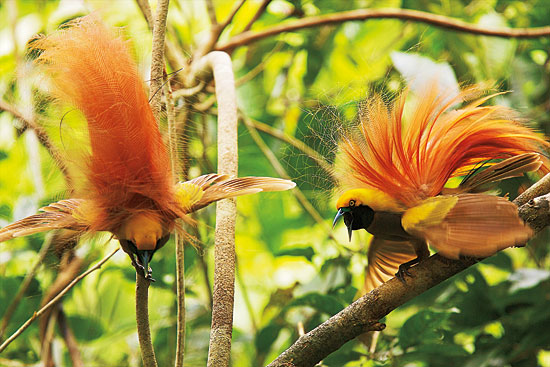The Quest To Film And Photograph Every Species Of Bird-Of-Paradise
Aru Islander Eli Karey explained what Tim Laman had to do: “Before you climb the tree in the morning, you must get some wax from your ear with your finger and rub it on the tree trunk. You must do this so the birds will come!
Which is how I found myself in the predawn darkness watching Tim wiggle a sweaty finger into his ear in honor of the local custom. We were standing at the base of a large tree, surrounded by climbing gear, in a remote forest on a rarely visited island partway between New Guinea and Australia. We had endured days of travel to reach this distant Indonesian outpost, and Tim was finally ready to haul his camera equipment up the rope, into a leaf-covered blind high in the canopy. With the help of the Karey clan, Tim’s blind had been made in the traditional style used by generations of bird hunters on the Aru Islands. If all went according to plan, Tim would document one of the greatest spectacles in the natural world: the communal courtship displays of the Greater Bird-of-paradise.


Our trip to the Aru Islands took place in late 2010 during the penultimate year of our nearly decade-long quest to scientifically document all of the species in the incredibly diverse family Paradisaeidae: the birds-of-paradise. This project took us all over the island of New Guinea, to several nearby islands, and to the rainforests of Australia. We made 18 expeditions, spent more than 500 days in the field, and visited more than 50 field sites.
Our journey began in 2004, when Tim Laman and I joined forces after he received an assignment to photograph birds-of-paradise for National Geographic (see page 6). By the time the article was complete, Tim had photographed 22 species—a huge success by any measure. But somewhere near the end of those first few years, perhaps in a fit of delirium induced by the tropical heat, we realized that our partnership offered a unique opportunity to continue. So we hatched a plan to do something nobody had ever attempted: to find and document all 39 bird-of-paradise species. We knew it would be a challenge, but we never imagined it would take another five years before our vision would be complete.
By going to the Aru Islands, Tim and I were following in the footsteps of the great 19th-century naturalist and explorer Alfred Russel Wallace. Like Wallace, we had come to these fabled islands to find the Greater Bird-of-paradise. Wallace made his voyage because he knew that seafaring traders had long been transporting Greater Bird-of-paradise skins from the Aru Islands to distant lands, where they were prized for their rarity and beauty. In the 16th century, some of those early “trade skins” made their way to Europe aboard the only ship to return from Magellan’s famous voyage around the world. Because of their exceptional appearance and the special way the skins were prepared by the Aru Islanders (with legs and wings removed to accentuate their plumes), the first bird-of-paradise skins to reach Europe caused a sensation. At that time, many believed that these ethereal creatures must have come from the biblical Garden of Eden. In other words, they were thought to be birds from paradise.
Text and images taken from All About Birds (read full article).
This is an example of a global CTA
Supporting Text for the global CTA
